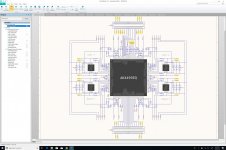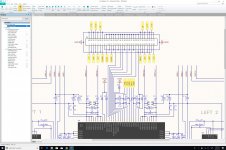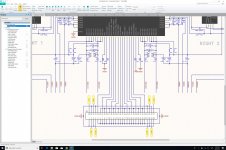Yeah, there are no hard and fast rules, but a single plane is probably the safest route to go. Single point grounds and star grounds often do not work well at high frequencies. In my experience, people always worry about high frequency currents, but those return in a very predictable path. It's the low frequency stuff that spreads on the plane. Sometimes you do need a single point connection, but it depends and it's a trade-off.
Got it!
We'll, I'd much rather design everything with a single ground plane... It's a lot easier that way. Let's just hope that it works.
Thanks a lot Chris, I can't tell you how valuable your watchful eyes are to this project...
Mill-Max 803 Interconnect Machined Pin Socket
We will probably use 4 × 4-pin Mill-Max 803 Interconnect Machined Pin Sockets for mounting our 4-channel Super Regulator board on top of the DAC board (Cf. Layout).
We will probably use 4 × 4-pin Mill-Max 803 Interconnect Machined Pin Sockets for mounting our 4-channel Super Regulator board on top of the DAC board (Cf. Layout).
With all due respect to Chris, the following is what concerns me about what Chis said a short time ago: But first, what he says is what I have done before building dacs, so I like the basic idea so long as it is for a dac as I would build it or as I would recommend to build it.
However, AKM has set up the eval board with two ground planes and a couple of pin header jumpers to tie the two ground plane together at the power inlet end of the board. Of course, the two grounds have to be tied together at the dac chip itself.
Then there is the matter of all the other module positions on the module 'plate' that may not be occupied by dac related modules. If there are two ground planes on the plate and it turns out there is interference between non-dac modules and the dac, then I would say put all the dac functions on the analog ground plane and use the digital ground plane for the other noise makers.
One thing we haven't been clearly told and which matters is whether all modules on the plate are going to have the same connectors as the modules that are dac related. Do the other modules share the same base level power supplies and grounding system? If so, we may be in trouble. But that's the whole idea of this thing as I understand it, one can plug anything anywhere. Plug the dac chip in one corner of the plate, plug noise makers between it and the power supplies and have fun.
Since there seems to be a lot of room for potential problems, I am hesitant to give advice I might use if I were building a dac or someone else was in what I would consider to be a wise and sensible way.
Since Ismael says he needs to do things the way is doing because that's how he learns and if he has to redo it a bunch of times its all okay. Given all the foregoing, I am inclined to say, 'let him do it the way he wants and then learn from it.' He can learn how to troubleshoot, etc. If Chris and or I give a bunch of easy answers to hard problems, what is really being accomplished by that?
However, AKM has set up the eval board with two ground planes and a couple of pin header jumpers to tie the two ground plane together at the power inlet end of the board. Of course, the two grounds have to be tied together at the dac chip itself.
Then there is the matter of all the other module positions on the module 'plate' that may not be occupied by dac related modules. If there are two ground planes on the plate and it turns out there is interference between non-dac modules and the dac, then I would say put all the dac functions on the analog ground plane and use the digital ground plane for the other noise makers.
One thing we haven't been clearly told and which matters is whether all modules on the plate are going to have the same connectors as the modules that are dac related. Do the other modules share the same base level power supplies and grounding system? If so, we may be in trouble. But that's the whole idea of this thing as I understand it, one can plug anything anywhere. Plug the dac chip in one corner of the plate, plug noise makers between it and the power supplies and have fun.
Since there seems to be a lot of room for potential problems, I am hesitant to give advice I might use if I were building a dac or someone else was in what I would consider to be a wise and sensible way.
Since Ismael says he needs to do things the way is doing because that's how he learns and if he has to redo it a bunch of times its all okay. Given all the foregoing, I am inclined to say, 'let him do it the way he wants and then learn from it.' He can learn how to troubleshoot, etc. If Chris and or I give a bunch of easy answers to hard problems, what is really being accomplished by that?
Last edited:
With all due respect to Chris, the following is what concerns me about what Chis said a short time ago: But first, what he says is what I have done before building dacs, so I like the basic idea so long as it is for a dac as I would build it or as I would recommend to build it.
However, AKM has set up the eval board with two ground planes and a couple of pin header jumpers to tie the two ground plane together at the power inlet end of the board. Of course, the two grounds have to be tied together at the dac chip itself.
Then there is the matter of all the other module positions on the module 'plate' that may not be occupied by dac related modules. If there are two ground planes on the plate and it turns out there is interference between non-dac modules and the dac, then I would say put all the dac functions on the analog ground plane and use the digital ground plane for the other noise makers.
One thing we haven't been clearly told and which matters is whether all modules on the plate are going to have the same connectors as the modules that are dac related. Do the other modules share the same base level power supplies and grounding system? If so, we may be in trouble. But that's the whole idea of this thing as I understand it, one can plug anything anywhere. Plug the dac chip in one corner of the plate, plug noise makers between it and the power supplies and have fun.
Since there seems to be a lot of room for potential problems, I am hesitant to give advice I might use if I were building a dac or someone else was in what I would consider to be a wise and sensible way.
Since Ismael says he needs to do things the way is doing because that's how he learns and if he has to redo it a bunch of times its all okay. Given all the foregoing, I am inclined to say, 'let him do it the way he wants and then learn from it.' He can learn how to troubleshoot, etc. If Chris and or I give a bunch of easy answers to hard problems, what is really being accomplished by that?
Mark,
You're bringing some really interesting points here. To make a long story short, the modularity goal of the OTO™ system will be difficult to achieve if we do not have a proper strategy for grounding. Ideally, all modules should adopt the same strategy, and the idea of having separate planes for AVSS and DVSS with some additional jumper(s) kinda makes sense to me. And as far as I can tell, this is a really good topic for further discussions.
I'll let the experts chime in...
Ismael
Since Ismael says he needs to do things the way is doing because that's how he learns and if he has to redo it a bunch of times its all okay. Given all the foregoing, I am inclined to say, 'let him do it the way he wants and then learn from it.' He can learn how to troubleshoot, etc. If Chris and or I give a bunch of easy answers to hard problems, what is really being accomplished by that?
Sure thing, but failure is not my primary objective. Learning is. Therefore, please do not just sit on the sideline to watch me fail in spectacular fashion, for the entertainment value of such a show would have a very limited shelf-life, for a very limited audience. 😉
I didn't check the PDF but if AKM does use two planes, then the safe thing to do is copy what they did. It might not be the best approach, and could lead to issues in compliance testing if any signals cross the split, but if you just want to ensure you achieve datasheet figures, it's safest since they have proven it and measured.
In general, this is more nuanced than just saying everything should be connected to one reference plane without caring about what, how, or where. My experience is that splitting the plane creates more problems than it solves, and any problem it does solve can usually be solved in another way. That's not to say it can't be done or doesn't solve a problem in some cases. I have split analog and digital planes successfully before in non-audio work, but by galvanic isolation of every signal that crosses over.
In general, this is more nuanced than just saying everything should be connected to one reference plane without caring about what, how, or where. My experience is that splitting the plane creates more problems than it solves, and any problem it does solve can usually be solved in another way. That's not to say it can't be done or doesn't solve a problem in some cases. I have split analog and digital planes successfully before in non-audio work, but by galvanic isolation of every signal that crosses over.
Since there seems to be a lot of room for potential problems, I am hesitant to give advice I might use if I were building a dac or someone else was in what I would consider to be a wise and sensible way
Fair enough... Nobody said that it would be easy...
In fact, I remember Chris writing that he followed the thread because it seemed quite ambitious.
Well, I think that was massively understated...
But that's what is making it fun, isn't it?
Guys: just to be clear, I'm having a ton of fun with this...
So please stay tuned and remain engaged. This simply can't be done without your help...
Last edited:
I didn't check the PDF but if AKM does use two planes, then the safe thing to do is copy what they did. It might not be the best approach, and could lead to issues in compliance testing if any signals cross the split, but if you just want to ensure you achieve datasheet figures, it's safest since they have proven it and measured.
In general, this is more nuanced than just saying everything should be connected to one reference plane without caring about what, how, or where. My experience is that splitting the plane creates more problems than it solves, and any problem it does solve can usually be solved in another way. That's not to say it can't be done or doesn't solve a problem in some cases. I have split analog and digital planes successfully before in non-audio work, but by galvanic isolation of every signal that crosses over.
Game on!
But what does it mean when we have an analog pin next to a digital pin on the connectors, with ground pins facing them on the other side of the connector? Do we connect one to the AVSS plane and the other to the DVSS plane like I did before you posted your reply? Should we revert to that design?
Game on!
But what does it mean when we have an analog pin next to a digital pin on the connectors, with ground pins facing them on the other side of the connector? Do we connect one to the AVSS plane and the other to the DVSS plane like I did before you posted your reply? Should we revert to that design?
Probably, it looks like AKM has done that, although there is only one DVSS connection on their entire header that I see at a quick glance.
...failure is not my primary objective. Learning is. Therefore...
Oh, you would learn a lot more that way. Seriously. But only if you didn't give up. You would get as much help and advice as you want/need. Nobody would let you fail as long as you wanted to keep learning, unless perhaps none of us could make the project succeed as conceived, given our cumulative knowledge and experience.
Oh, you would learn a lot more that way. Seriously. But only if you didn't give up. You would get as much help and advice as you want/need. Nobody would let you fail as long as you wanted to keep learning, unless perhaps none of us could make the project succeed as conceived, given our cumulative knowledge and experience.
Let's carry on then... Thanks mate!
Probably, it looks like AKM has done that, although there is only one DVSS connection on their entire header that I see at a quick glance.
Indeed, and that does not make much sense to me. The only reasonable explanation I can come up with is that it does not matter that much, but I can't see how what I am doing could hurt either...
Here is the North side...
There seems to be a lot more art than science in a lot of this...
Which is probably a good thing for us mortal beings...
Attachments
There seems to be a lot more art than science in a lot of this...
Which is probably a good thing for us mortal beings...
One of the books you are supposed to be reading is entitled, The Art of Electronics. That said, everything has an underlying physical basis at some level.
Could be you will encounter some things that we do not have fully developed research to understand as well as we would like. Could also be a demonstration will be waiting in Auburn for someday when you can visit.
One of the books you are supposed to be reading is entitled, The Art of Electronics. That said, everything has an underlying physical basis at some level.
Could be you will encounter some things that we do not have fully developed research to understand as well as we would like. Could also be a demonstration will be waiting in Auburn for someday when you can visit.
Of course!
The art comes in not because nature is magic. It comes in because we do not understand it fully, and nobody ever will.
It's a bit like a cook: you could ask the cook to get a chemistry PhD before cooking the meal, but if you do, you're quite likely to die out of starvation before that happens.
Only a rare few can hope to become chemists. For the rest of us, cook or chef is the best we can hope for.
You're a chemist. I'm a cook apprentice. And for now, all I can hope for is a chance to wash the dishes and mop the floor...
One day, I'll know how to cook the rice...
Only a rare few can hope to become chemists. For the rest of us, cook or chef is the best we can hope for.
It isn't necessarily that. Its sometimes more a question of what one wants do in the time that one has available. Thoroughly research a few molecules found in food, or make gourmet meals?
Last edited:
Indeed, and that does not make much sense to me. The only reasonable explanation I can come up with is that it does not matter that much, but I can't see how what I am doing could hurt either...
Here is the North side...
There seems to be a lot more art than science in a lot of this...
Which is probably a good thing for us mortal beings...
It's definitely a science, but it's a real pain and a lot of work to figure out the exact optimal solution. Often, rules of thumb are enough to get you close.
It isn't necessarily that. Its sometimes more a questions of what you want do in the time that you have available. Thoroughly research a few molecules found in food, or make gourmet meals? Too many molecules with different properties in different situations to completely understand a whole meal, given a lifetime to do the work.
Precisely!
- Home
- Source & Line
- Digital Line Level
- 8 × AK5578EN + 8 × AK4499EQ ADC/DAC Boards


